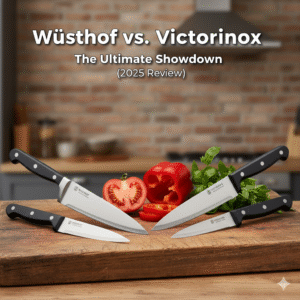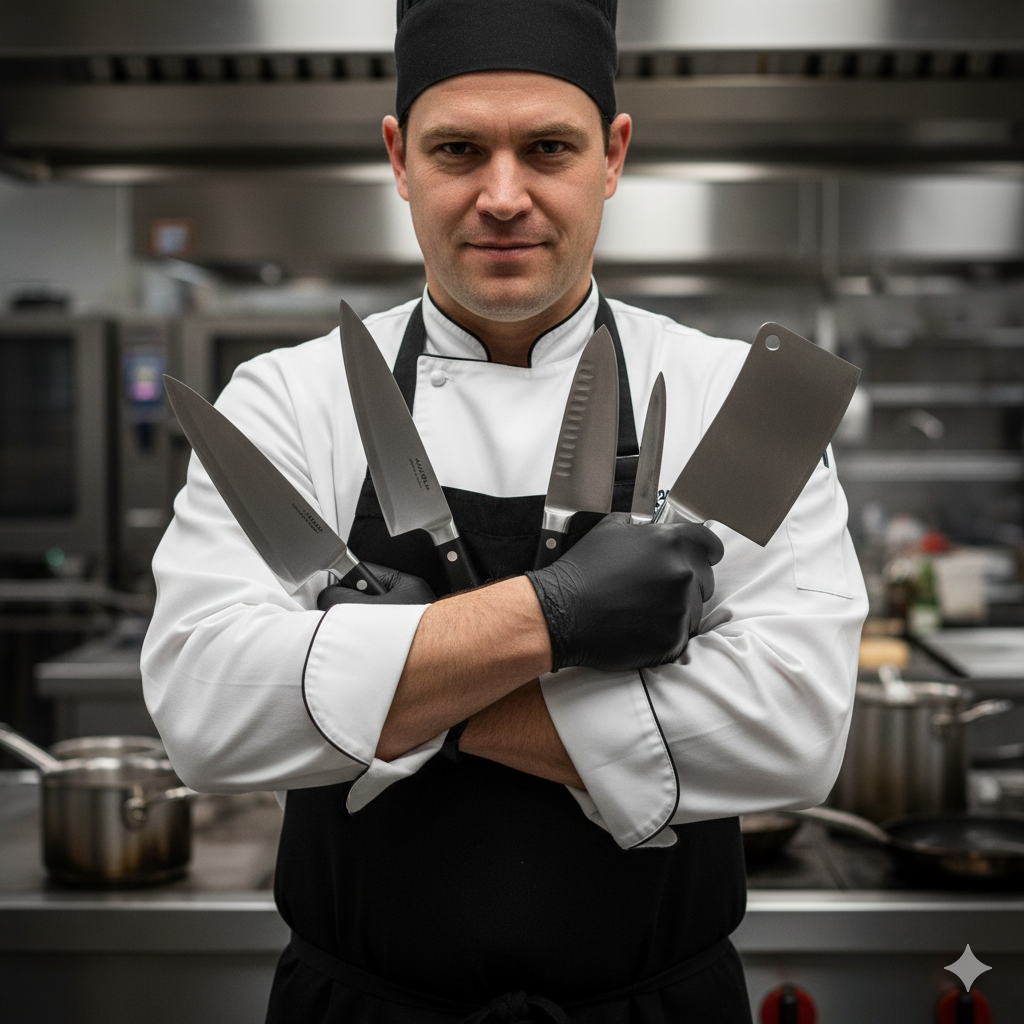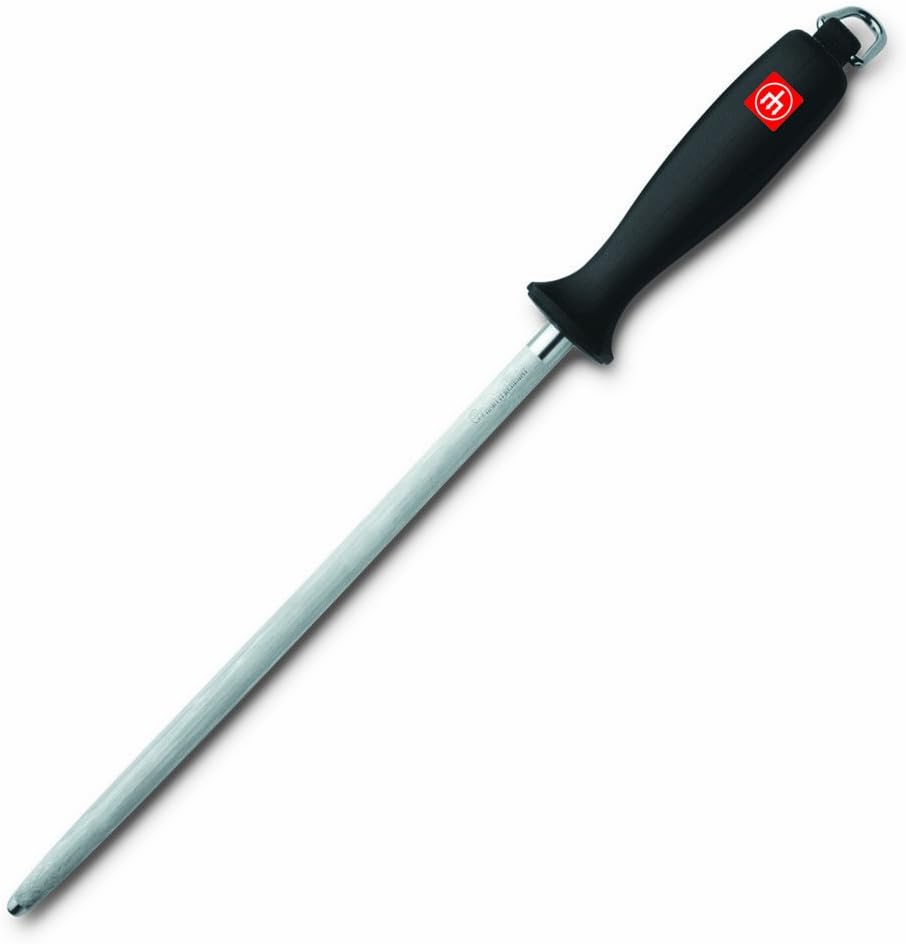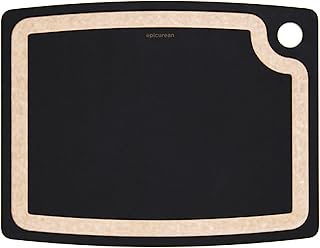Wüsthof vs. Victorinox: The Ultimate Showdown (2025 Review)
This is the ultimate kitchen crossroads. It’s a choice every serious cook eventually faces: do you invest in the Wüsthof Classic, the iconic, German-forged “buy it for life” heirloom? Or do you choose the Victorinox Fibrox Pro, the shockingly affordable Swiss powerhouse that’s the secret weapon of professional chefs everywhere? This is a battle between prestige and pragmatism, between a lifelong investment and the undisputed king of value. I’ve owned and relied on both of these knives for years, and I’m here to give you the brutally honest, hands-on comparison to help you make the single most important decision for your kitchen.
Affiliate Disclosure & E-E-A-T Commitment: I’m a passionate home cook, not a corporate shill. This review is built on years of personal experience. To support my work, this post contains affiliate links. If you purchase through them, I may earn a commission at no extra cost to you. My promise is to provide trustworthy, expert advice to help you choose wisely.
The Short Answer (TL;DR)
If you’re in a hurry, here’s the essential difference:
- Buy the Wüsthof Classic if you want a premium, perfectly balanced, and durable forged knife that enhances the cooking experience. It’s a lifelong investment in craftsmanship and feel. It’s the luxury sedan of kitchen knives.
- Buy the Victorinox Fibrox Pro if you want the absolute best cutting performance for the lowest possible price. It’s a lightweight, incredibly sharp, and practical tool that’s trusted by professionals for its sheer utility. It’s the reliable, all-terrain pickup truck of kitchen knives.
A Clash of Philosophies: The Heirloom vs. The Tool
You can’t understand these knives without understanding their core philosophies.
Wüsthof: German Engineering as an Art Form. Forged in Solingen, Germany, for over 200 years, a Wüsthof is designed to be the centerpiece of a kitchen. It’s about creating an instrument with perfect balance, a satisfying heft, and the durability to be passed down through generations. Every feature, from the full bolster to the triple-riveted handle, is about creating a superior, holistic user experience.
Victorinox: Swiss Pragmatism as a Science. From the makers of the Swiss Army Knife, a Victorinox is a solution to a problem. The problem? Needing to cut things efficiently, safely, and affordably. Every non-essential element is stripped away. There are no fancy materials or aesthetic frills. There is only the blade, the grip, and the cut. It is a masterpiece of pure, unadulterated function.
Comparison Table: Wüsthof Classic vs. Victorinox Fibrox Pro
| Feature | Wüsthof Classic | Victorinox Fibrox Pro |
|---|---|---|
| Philosophy | German Heirloom (Experience) | Swiss Utility (Tool) |
| Construction | Forged | Stamped |
| Steel | X50CrMoV15 (~58 HRC) | High-Carbon Stainless (~56 HRC) |
| Weight & Balance | Heavier, perfectly balanced | Lightweight, handle-focused |
| Handle Material | POM (Polyoxymethylene) | Fibrox (TPE), non-slip |
| Bolster | Yes (Full Bolster & Tang) | None |
| Edge Retention | Excellent | Good |
| Price | ~ $170 – $200 | ~ $40 – $50 |
The Flagship Battle: In-Depth, Hands-On Reviews
Let’s put the icons head-to-head: the Wüsthof Classic 8-inch and the Victorinox Fibrox Pro 8-inch chef’s knives.

Wüsthof Classic 8-Inch Chef’s Knife
Picking up the Wüsthof Classic is an experience. You feel the weight, the perfect balance point right at the bolster where your fingers rest. It feels like a serious, professional tool. The forged blade powers through dense vegetables like carrots and squash with a confidence the lighter Victorinox can’t match. The famous curved belly makes rock-chopping herbs and garlic feel effortless and natural. This knife doesn’t just cut; it makes you *feel* like a better cook. It’s an investment in the joy of cooking itself.
Pros
- Perfect weight and balance
- Extremely durable forged construction
- Excellent edge retention
- Comfortable, classic handle
- “Buy it for life” heirloom quality
Cons
- Significant financial investment
- Full bolster complicates sharpening

Victorinox Fibrox Pro 8-Inch Chef’s Knife
The Victorinox Fibrox Pro is the opposite first impression: it feels almost shockingly light. But then you start cutting. It glides through an onion with zero resistance. It creates paper-thin tomato slices from its razor-sharp factory edge. The Fibrox handle, while not pretty, feels incredibly secure, especially when your hands are wet. After twenty minutes of rapid prep work, you notice something amazing: no fatigue. Its lightweight, nimble nature makes it a tireless workhorse. It’s not an heirloom, it’s a high-performance tool that asks for nothing but to get the job done. For a deeper look, check out my full Victorinox chef knife reviews.
Pros
- Unbeatable performance-per-dollar
- Incredibly sharp and easy to maintain
- Lightweight design reduces fatigue
- Legendary non-slip grip
Cons
- Lacks the satisfying weight of a forged knife
- Plain, utilitarian appearance
Is the Wüsthof Really Worth the 4x Price Difference?
This is the central question. Let’s be brutally honest: No, the Wüsthof Classic is not four times better at cutting than the Victorinox Fibrox Pro. This is a classic case of the law of diminishing returns. The Victorinox gets you 90% of the way to peak performance for about 25% of the price.
So, what are you paying for with that extra money? You are paying for:
- Balance and Feel: The heft and perfect balance of the forged Wüsthof is a tangible benefit that many experienced cooks find essential. It feels more stable and controlled.
- Durability: The full-tang, forged construction is inherently stronger and more durable than a stamped blade. A Wüsthof is built to last for 50+ years.
- Edge Retention: The slightly harder, more refined German steel will hold its working edge noticeably longer than the Victorinox, meaning less frequent sharpening sessions.
- Craftsmanship and Prestige: You are paying for the heritage of Solingen, the fit and finish, and the pride of owning an heirloom-quality instrument.
My Verdict on Value: If you are a pragmatist, the Victorinox is the smartest purchase you can make. If you are a passionate home cook who values the *experience* and feel of your tools as much as the result, the Wüsthof is a worthy and justifiable investment.
Beyond the Chef’s Knife: Comparing Their Full Lineups
A brand is more than just one knife. Here’s how their philosophies extend to other essential blades.
Paring Knives
The difference is stark. The Wüsthof Classic Paring Knife is a miniature chef’s knife—forged, bolstered, and beautifully balanced for intricate work. The Victorinox Paring Knife is a tiny, colorful scalpel that costs less than a cup of coffee. It’s so cheap and effective that many pros treat them as semi-disposable. My advice: buy the Victorinox in a pack of three and don’t look back.
Bread Knives
This is a much closer race. Both brands make world-class serrated bread knives. The Wüsthof Classic Bread Knife often features a double-serration (a serration within a serration) that is fantastic for hard crusts. The Victorinox Bread Knife has a famous offset handle that provides excellent knuckle clearance and a wavy serration that is exceptionally effective. This is one category where the Victorinox is not just a value choice, but a top contender regardless of price.
The Broader Market Context: Where Do They Fit?
Understanding this matchup requires knowing the whole field. Wüsthof’s primary rivals are not in the value category, but at the premium end. The legendary Shun vs. Wüsthof debate pits German durability against Japanese precision. And of course, no discussion of German knives is complete without comparing it to its Solingen neighbor, Zwilling, a topic we cover in our definitive Wüsthof vs. Zwilling vs. Shun guide.
Victorinox, on the other hand, reigns supreme in the value space, making it one of the best affordable chef knives available. Its main rival for the budget-conscious buyer is Henckels, a duel we break down in our Henckels vs. Victorinox article. Seeing how all these brands, from budget to luxury, stack up is why our guide to the best chef knife brands is an essential read for any aspiring cook.
Frequently Asked Questions
Is Wüsthof really that much more durable than Victorinox?
Yes. The fully forged, full-tang construction of the Wüsthof Classic is inherently stronger than the stamped blade of the Victorinox. You are far less likely to ever bend or break a Wüsthof. That said, the Victorinox is incredibly tough for a stamped knife and is more than durable enough for 99.9% of kitchen tasks.
Which knife is easier for a beginner?
The Victorinox. Its low cost removes the “fear factor” of using an expensive knife. It’s also more forgiving if you accidentally damage it. Furthermore, the lack of a bolster makes learning to sharpen along the entire edge much simpler.
Why do so many professional chefs use the cheaper Victorinox?
In a professional kitchen, knives are tools that see extreme abuse. They get dropped, used by multiple people, and sent through harsh sanitizers. The Victorinox is cheap to replace, has a non-slip handle for safety in chaotic environments, and its performance is top-notch. It’s the most logical, pragmatic choice for that specific environment.
Final Verdict: The Choice of The Head vs. The Hands
After years of deliberation, I believe the choice between Wüsthof and Victorinox comes down to what you value more: logic or feeling.
You Should Buy Wüsthof If:
- You value the feel and experience of cooking. You enjoy the satisfying weight and perfect balance of a premium, forged tool.
- You are a “buy it once, cry once” person. You want to make a single investment in an heirloom-quality knife that will last a lifetime.
- You do a lot of heavy-duty chopping. The heft of the Wüsthof provides power and stability that the Victorinox can’t match.
You Should Buy Victorinox If:
- You are a pragmatist. You want the most cutting performance possible for your dollar, without exception.
- You prefer a lightweight, nimble knife. You do high volumes of prep and want to minimize fatigue.
- You are a beginner, a student, or work in the food service industry. Its combination of performance, durability, and low cost is unbeatable in these contexts.
My final piece of advice is this: there is no wrong answer. The Wüsthof Classic is a flawless example of a premium German workhorse. The Victorinox Fibrox Pro is a flawless example of a high-performance utility knife. Choosing between them is a luxury. Whether you lead with your head or your hands, you will end up with one of the best kitchen tools ever made.























